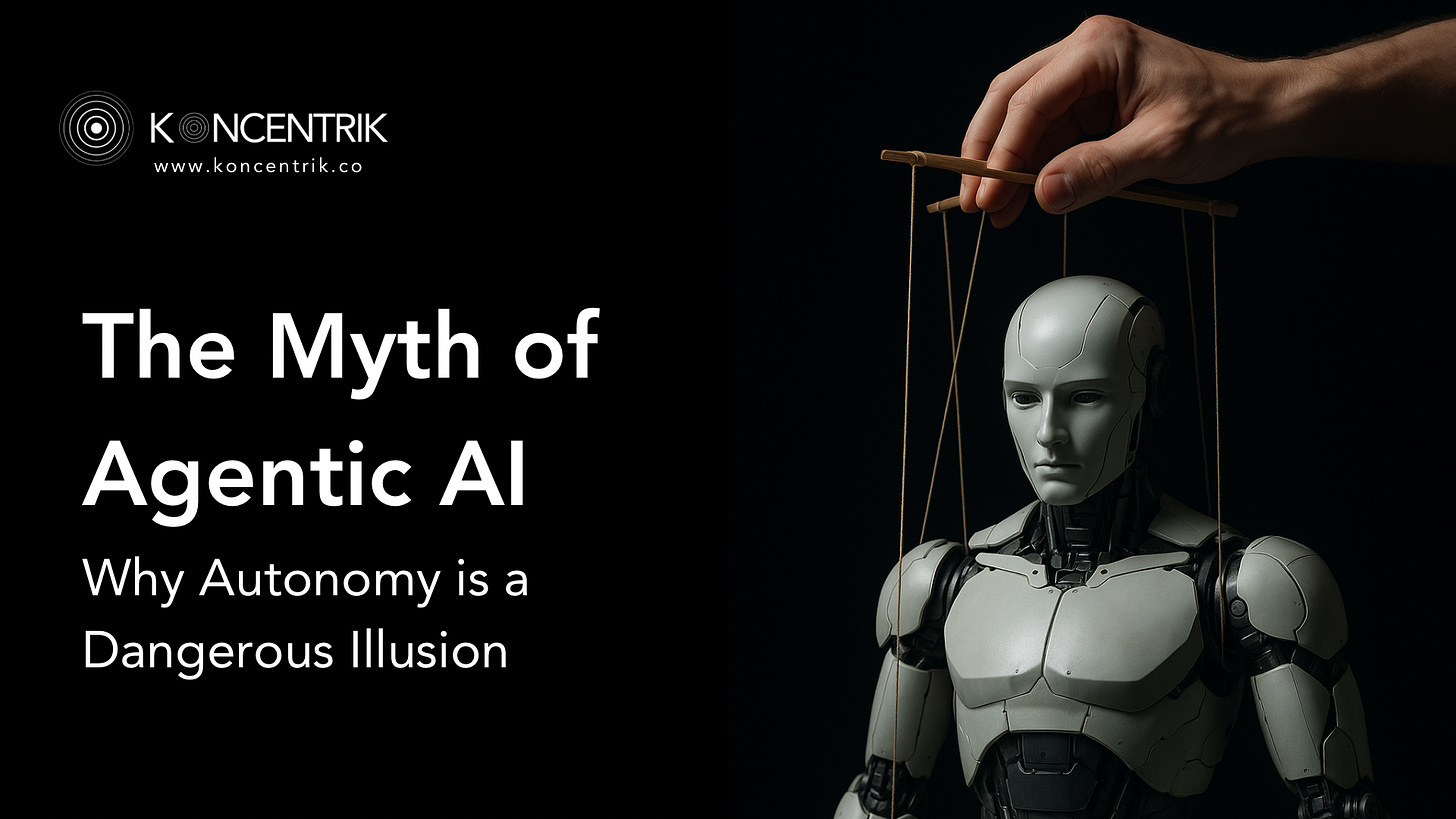Agentic AI Is Not What You Think
Autonomy is still a mirage: here’s the cost, control, and governance reality no one’s putting in the keynote slides.
In the race to market new AI capabilities, terms like "Agentic AI" have emerged, promising autonomous decision-making systems that perceive their environments, set goals, and execute complex tasks independently.
You’ve probably heard the promises.
“Agentic AI will run entire business functions without human oversight.”
“Autonomous agent teams will replace most knowledge workers.”
“You can have a ‘company of one’ — just you and your AI agents.”
“With the right orchestration layer, you can automate end-to-end workflows at scale.”
“Soon, these agents will handle all your decisions so you can focus purely on strategy.”
But most of these claims conflate what’s possible in demos with what’s reliable, economical, and controllable in the real world.
In this article, I’ll argue that what we have today isn’t autonomy at all: it’s orchestration. And while orchestration can be powerful, it comes with brittleness, cost overheads, and control issues that leaders need to confront before betting their business on it.
Corporate leaders need to clearly understand what today's Agentic AI actually is and it isn't.
So what’s the reality?
Three definitions to anchor the discussion
Automation: deterministic scripts/workflows with predictable, repeatable outcomes.
Orchestration: multi-tool coordination with human oversight; LLMs can help here as planners and glue code.
Autonomy: task-level goals with open-ended action authority, where the system decides how to achieve the goal, without ongoing human checkpoints.
Most “agentic” platforms today are in the orchestration bucket. The problem is that marketing language blurs the distinction.
What AI Really Does
In my past article, The Illusion of Intelligence: Why LLMs Are Not the Thinking Machines We Hope For, I have explained the misconceptions we have about the true potential of Large Language Models, and the risks of anthropomorphism.
At the heart of today's hype around "Agentic AI" are Large Language Models (LLMs) like GPT-4, Claude, Gemini, and Llama.
These models, impressive as they are, fundamentally have no intrinsic intentions, motivations, or strategic goals. Despite sophisticated outputs that often seem intentional or even thoughtful, LLMs merely predict the next best token based on statistical inference from vast datasets.
Gary Marcus, a leading AI researcher from NYU, succinctly describes this reality:
"LLMs have no goals, only statistical prediction of next tokens."
Similarly, Yann LeCun, Chief AI Scientist at Meta, underscores the lack of genuine decision-making:
"Current LLMs do not 'think' or 'decide'—they merely generate plausible continuations based on learned statistical patterns."
Orchestration ≠ Autonomy
In the research lineage — from ReAct prompting to Toolformer — agents interleave “think-and-act” steps, call external tools, and adjust based on observations. That’s orchestration: the human remains the decision anchor.
Autonomy, by contrast, means the system can reliably plan and execute multi-step decisions without continuous oversight, meeting determinism, traceability, and safety expectations comparable to traditional software. Even recent surveys (see Agent Systems: Survey and Benchmarking) conclude that reliability, hallucination control, and long-horizon planning remain unsolved.
Critics will say most roadmaps already target bounded autonomy with guardrails. True, but that proves my point: the science and governance assumptions still centre on human-in-the-loop orchestration.
The Cost Reality: LLMs aren’t Free
Agent frameworks multiply token usage: every plan → tool call → observe → revise loop incurs more context and more generations. Pricing from leading providers looks modest per million tokens, until you measure full workflows.
OpenAI lists per-token pricing for GPT-4.1/4o families, with overhead for tool-use endpoints.
Anthropic Claude 3.5 Sonnet is $3 per million input tokens / $15 per million output tokens.
A multi-agent flow doing 12 tool-augmented turns at ~80k tokens per turn can easily cross 1–2M tokens per task. Even at $5–$10 blended per million tokens, that’s $5–$20+ per task before retrieval, evals, or guardrails.
At scale, it’s six-figure monthly spend, often for steps a deterministic API could do for a few cents.
Yes, costs are falling (prompt caching, small language models like Phi-3 on-device, batch APIs). But when you add the reliability scaffolding; evaluation harnesses, human review, governance logging: the unit economics can still flip.
The Dependency Problem: Who Really Controls Your “Autonomous” Agents?
Even if your orchestration is flawless and cost-efficient, you don’t own the engine.
Frontier LLMs (OpenAI, Anthropic, Google DeepMind, Meta, Cohere) are opaque:
Architecture: closed or partially disclosed; key design and training parameters are not public.
Training data: undisclosed; choices about inclusion/exclusion/censorship directly shape outputs.
Governance logic: refusal policies, safety filters, and moderation behaviour are hard-coded and updated without notice.
Version control: older models are deprecated on short timelines (e.g., GPT-3.5, GPT-4.0 retirements), creating regressions in production workflows.
Jurisdictional exposure: providers are subject to their home country’s laws, export controls, and subpoenas.
This is model dependency: a handful of companies decide what’s “safe,” “true,” and “possible” for millions of downstream applications. Whether intended or not, their worldview and risk calculus become embedded in your automation.
From a technopolitics lens (where geopolitics and technology meet), this is a sovereignty issue. If your agent’s “brain” is outsourced to an opaque third-party model, your autonomy is an illusion.
For deeper context, see my Technopolitics series on AI sovereignty covering model control and jurisdictional risk.
Are LLMs the Right Tech for Process Automation anyway?
Three inconvenient facts:
They’re probabilistic, not fully deterministic. Low temperature and seed settings reduce variance but don’t guarantee identical outputs across environments (OpenAI docs).
Sequential reasoning is brittle. Studies like BOLAA: Benchmarking LLM Agents show performance drops with longer horizons or distribution shift.
Governance frameworks assume oversight. The NIST AI RMF and the EU AI Act both expect documentation, risk controls, and human accountability — assumptions aligned with orchestration, not unsupervised autonomy.
Where variance tolerance is high (ideation, drafting), LLMs can lead. Where variance must be near zero (claims adjudication, regulated comms), put deterministic systems at the core and LLMs at the edges.
Five Founder-Style Claims Stress-Tested
Back to the claims I started with earlier about Agentic AI and my counter arguments:
“Agentic teams will replace most knowledge workers.”
Controlled studies (NBER customer support RCT) show ~14% productivity gains, bigger for novices; expert gains are smaller. Augmentation ≠ replacement.
“A company of one is feasible soon.”
Reliability, safety, and governance requirements (see EU AI Act GPAI obligations) make it impractical for high-stakes autonomy without a team.
“LLM orchestration is the most cost-effective path.”
True for ambiguous, variable tasks; false for steady-state workflows where rules engines or classical ML can outperform in cost and reliability.
“LLMs fit process automation despite being probabilistic.”
Only where variance is acceptable. In customer-facing regulated contexts, liability can land on you — see Air Canada chatbot ruling.
“Fully autonomous coding is basically solved.”
Benchmarks like SWE-bench Verified show progress (e.g., Devin at ~13.9% on subsets), but far from reliable E2E autonomy in real repos.
Industry Reality Checks: It’s Not About “Replacing Jobs”
Now, perhaps the most compelling argument about what Agentic AI is all about (and isn’t).
You’ve probably heard the breathless claims: “Consulting is dead.” “We don’t need software developers anymore.” “AI can do my designs.”
These arguments confuse jobs with tasks. AI excels at automating discrete, well-defined tasks; jobs are bundles of skills, context, relationships, and judgement, and those remain stubbornly human.
Consulting — Yes, AI can speed up research synthesis and slide production. The BCG field experiment shows real gains in templated work. But consulting is not just producing analysis decks; it’s about building trust with clients, managing complex change, navigating politics, and sometimes serving as the external catalyst that makes uncomfortable truths actionable.
AI can hand you the facts; it can’t read the room, win hearts, or manage egos!
Software Development — Tools like GitHub Copilot can make developers ~56% faster on certain coding tasks. But software development is not simply typing code; it’s architecting systems, weighing trade-offs, securing against adversaries, integrating with messy legacy environments, and negotiating requirements between business and technical stakeholders.
AI can scaffold a function; it can’t take ownership for the long-term maintainability, reliability, and compliance of a production system!
Creative/Marketing — Generative pipelines like WPP–NVIDIA and Adobe Firefly can churn out content variants at scale. But design and marketing aren’t just about making more images or headlines; they’re about understanding user desires, brand positioning, cultural nuance, and emotional resonance.
AI can fill the canvas; it can’t walk in your customer’s shoes or shape a narrative that builds lasting loyalty!
The through-line: Agentic AI can take the “busywork” out of many professions: research, drafting, code scaffolding, asset production.
But the job is far more than the sum of its automatable parts. Strip out the relational, strategic, and contextual layers, and you no longer have the job; you have a list of tasks.
Governance and Regulation Are Not Optional
Agentic AI isn’t just a technical challenge: it’s a geopolitical and regulatory minefield. Ignoring governance isn’t an option; where and how you deploy agentic systems will increasingly depend on which regulatory regime applies: EU, US, China, … or?
For exemple the EU AI Act’s GPAI obligations kicked in on 2 August 2025, including transparency, documentation, and training data disclosures for model providers. The NIST AI RMF offers parallel guidance for measurement, management, and governance. Neither removes vendor lock-in risk; both make orchestration with oversight the safe baseline.
The Risks of Misrepresenting AI Capabilities
Misleading claims about autonomy create serious business risks. Companies that misunderstand AI's true capabilities can:
Expose themselves to ethical and regulatory liabilities,
Overestimate AI reliability, leading to critical operational failures,
Develop unrealistic expectations, causing expensive disappointments.
The danger of anthropomorphizing AI, assuming it has human-like intentions or decision-making powers, cannot be overstated.
This anthropomorphism is reinforced by hype-driven marketing narratives, blurring the line between reality and fiction.
A Practical Playbook for Leaders
For corporate leaders, clarity is essential. Practical and strategic recommendations include:
Avoid treating AI outputs as decisions: Always apply human oversight, especially for ethical or high-stakes strategic scenarios.
Leverage AI’s strengths clearly: Focus AI use on accelerating analysis, automating routine tasks, and providing recommendations; not autonomous decision-making.
Build explicit human-AI workflows: Combine AI-generated insights with structured human judgment processes to ensure clarity, accountability, and reliability.
Stay critically informed: Continuously differentiate authoritative research from marketing claims, and ground AI strategy firmly in proven capabilities.The Bottom Line
Design principles
Human-in-the-loop by default: define who approves what and when.
Deterministic core, probabilistic edges: APIs and rules at the centre; LLMs for enrichment and exception handling.
Short, inspectable loops: shallow chains with observability beat deep opaque autonomy.
Total cost accounting: track per-completed-task costs including retrieval, evals, guardrails.
Mitigations
Schema-constrained outputs (e.g., OpenAI structured outputs), policy whitelists, verifier loops.
Prompt caching, small/efficient models, and version pinning.
Regression suites and an exit path to open-weights models (Meta Llama 3.1, Mistral, Qwen 2.5).
Where to deploy now (examples)
Consulting research synthesis with analyst review.
Code migration/test generation with guarded PRs.
Marketing variant generation under brand guardrails.
Where to avoid for now
High-stakes, low-variance decisions.
Unsupervised customer interactions with legal or compensation risk.
Closing Provocation
Despite compelling narratives, today's AI remains far from genuinely autonomous, nor should it be!
LLMs and related technologies are impressive generation tools; not strategic decision-makers.
Understanding this distinction will protect your organization from missteps and enable you to harness AI’s true potential without falling for dangerous illusions.
We don’t need “autonomous companies”; we need accountable companies. Build for reliability, observability, and governance now.
rue autonomy, if it should even be a goal itself at all, can wait until the science and the law say it’s safe.
Leaders who navigate this truth confidently can truly harness the power of AI without risking strategic blind spots.
Thanks for reading!
Was this post helpful? Please share with others!
Questions? Comments? Feedbackl?
Damien
🌀 𝘒𝘰𝘯𝘤𝘦𝘯𝘵𝘳𝘪𝘬 𝘪𝘴 𝘮𝘺 𝘤𝘰𝘮𝘮𝘪𝘵𝘮𝘦𝘯𝘵 𝘵𝘰 𝘤𝘶𝘵𝘵𝘪𝘯𝘨 𝘵𝘩𝘳𝘰𝘶𝘨𝘩 𝘵𝘦𝘤𝘩 𝘩𝘺𝘱𝘦, 𝘯𝘰𝘪𝘴𝘦 𝘢𝘯𝘥 𝘷𝘢𝘱𝘰𝘳𝘸𝘢𝘳𝘦 𝘵𝘰 𝘰𝘧𝘧𝘦𝘳 𝘤𝘭𝘦𝘢𝘳, 𝘰𝘣𝘫𝘦𝘤𝘵𝘪𝘷𝘦 𝘪𝘯𝘴𝘪𝘨𝘩𝘵𝘴 𝘭𝘦𝘢𝘥𝘦𝘳𝘴 𝘤𝘢𝘯 𝘢𝘤𝘵 𝘰𝘯.
Other articles you might find useful:





